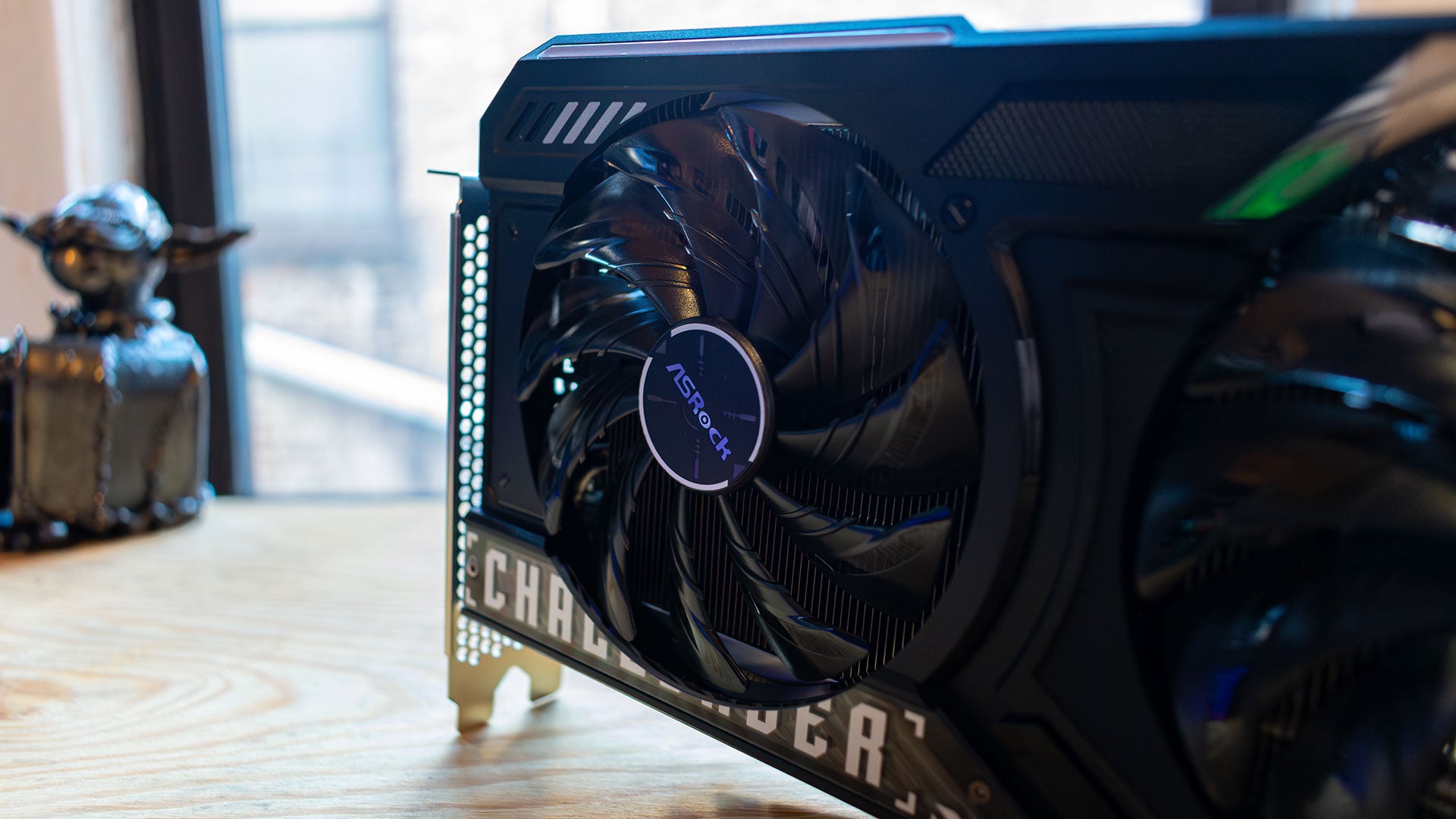The Intel Arc B580 surprised me when it launched in December 2024 by simply providing an excellent value for a $249 graphics card, especially in an era where GPUs are getting more expensive with each generation. The Intel Arc B570 also provides an awesome experience at a bargain price, but because it’s not much cheaper than the B580, it becomes harder to recommend when you can just spend an extra $30 and get significantly better performance.
To be clear, $30 is $30, and that price difference can matter for a lot of people. But when that 8% difference in price means a 10-20% difference in performance, the B580 is clearly the superior buy.
Specs and Features
The Intel Arc B570 is built on the same Xe2 architecture as its big sibling, the Arc B580, and even features a GPU that looks eerily similar. Just like the B580, the B570 has the same SoC, the BMG-G21, with all its 19.6 billion transistors. The only difference is that two of the Xe Cores have been disabled, leaving the B570 with 18 cores to the B580’s 20 cores.
Why would Intel just disable two cores? Well, when you’re manufacturing GPUs, a number of units will have little faults in them, and you can restore them to full functionality by just disabling a few of the cores. GPU makers will usually sell these GPUs as a lower-end graphics card to make up for some of the losses, rather than just destroying them – a process known as binning. This isn’t an approach that’s unique to Intel – AMD and Nvidia do it all the time, too. But what it results in is a graphics card that uses the same basic GPU as a more powerful unit, but with around 10% less active silicon. You’re only paying 8% less for it, so that makes sense – it even sounds like a good deal.
However, the Intel Arc B570 also has a lower clock speed, with the peak graphics clock coming in at 2,750MHz, compared to the B580’s 2,850MHz. Combine that with 10GB of VRAM on a 160-bit bus, compared to 12GB of VRAM on a 192-bit bus for the B580, and the odds start stacking up against the B570 to hold its own.
The final nail in the coffin is the power budget, which is limited to a theoretical 150W. However, in my testing suite, the Intel Arc B570 peaked at about 131W of power. Less power consumption is usually a good thing, but at the same time, more power typically means better performance. Even though the Intel Arc B570 only has 10% less active Xe Cores than the B580, it has a 16% lower power budget, which only spells trouble when it comes to performance – but more on that later. All of this can be explained by the Xe Cores on the B570 not being quite as efficient as the B580, which would explain Intel’s conservative approach to power budget and clock speed. But if it results in a worse product, that doesn’t matter much, especially when Intel could have dropped the price by $10-$20 more – a $199 B570 would be a much more attractive buy than a $219 one, after all.
Luckily, because the Intel Arc B570 is built on the Xe2 graphics architecture, it gets access to the awesome new features added with this generation of cards. Features like XeSS Frame Generation bring AI-powered frame interpolation to this budget graphics card. Just like Nvidia’s DLSS 3 FG, XeSS-FG analyzes data from each frame to create entirely new frames. Meanwhile, XeLL, or Low Latency, zeroes out the CPU render queue to cut down on latency when you’re gaming. This ends up being necessary when frame generation is enabled, as those interpolated frames introduce latency, and need XeLL to avoid introducing noticeable input lag.
Performance
When the dust settles, the Intel Arc B570 is a capable little graphics card at 1440p, and especially at 1080p, where it really shines. If you’re still using a 1080p gaming monitor, it’s rare to find a game where the B570 won’t excel with all the settings cranked, and that includes ray tracing.
In 3DMark, the Intel Arc B570 scores 1,946 points in Speed Way, compared to 2,468 from the Arc B580 and 2,042 from the AMD Radeon RX 7600, making for a sizable drop in performance. The delta between the B570 and B580 narrows a bit in Steel Nomad, with 2,675 and 3,082 points, respectively. 3DMark is better for testing the theoretical limits of a graphics card, rather than real world performance, but a 22% gap between the B570 and B580 doesn’t look pretty for the slightly more affordable GPU.
In Call of Duty: Black Ops 6 at 1440p, I tested on the ‘extreme’ preset with vendor appropriate upscaling – XeSS for Intel, FSR for AMD, etc – on the ‘Balanced’ setting, and found that the B570 delivers a very playable 64 fps. Lower the resolution to 1080p, and that number goes up to 74 fps. However, you can spend $30 more on the B580 and get 73 fps at 1440p and 83 fps at 1080p. This is going to be a recurring theme.
It’s actually surprising how well the B570 handles Cyberpunk 2077. This game typically prefers Nvidia graphics cards, especially with ray tracing enabled, but the Arc B570 gets an admirable 64 fps at 1080p, compared to 72 fps from the B580. Considering the $249 Radeon RX 7600 still fails to reach past 42 fps at 1080p, it could be a lot worse here.
Metro Exodus: Enhanced Edition is a weird game to test, as the only upscaling it supports is DLSS – which means I test the game with it disabled. This was one of the first games to force ray tracing on, and the Arc B570 is only able to get an average of 46 fps on the Extreme preset at 1080p. Likewise, the B580 struggles at the same resolution and settings, getting 52 fps. Even the Nvidia RTX 4060 has similar struggles in this game, though, getting 43 fps.
In Red Dead Redemption 2, the Arc B570 is able to keep up at both 1440p and 1080p, getting 76 fps and 88 fps, respectively. This is a game that only supports FSR, which means I do enable it for all vendors, but what’s surprising is that the B570 manages to outperform the Radeon RX 7600 – even though the upscaler is an AMD technology. Impressive stuff. However, the B580 still carries a 14% lead in this game with 87 fps at 1440p and 101 fps at 1080p.
Total War: Warhammer 3 is one of the few games in my testing suite that doesn’t support either ray tracing or upscaling, so it gives a clear picture on pure rasterization performance. And, well, the B570 still trails the B580 by 17% at 1080p, despite an 8% price gap.
Surprisingly, Assassin’s Creed Mirage seems to narrow the gap between the B580 and B570. This is a game that’s pretty heavy on the CPU, which is something to be aware of due to the CPU overhead issues going on with Battlemage right now, spotted by HardwareCanucks. However, paired with an AMD Ryzen 7 9800X3D, the B570 manages to get an average of 81 fps at 1440p, compared to 91 fps from the B580. However, keep in mind that the RTX 4060 gets 126 fps at this same resolution, with the AMD Radeon RX 7600 getting 95 fps. This makes Mirage an outlier in favor of Nvidia, but it’s still something to be aware of if you play a lot of Assassin’s Creed.
When I test Black Myth Wukong, I set it to the Cinematic preset, which is extremely demanding, no matter what graphics card you have in your system. Both Intel graphics cards struggle in this game, with the Intel Arc B570 managing 26 fps at 1080p, with the B580 only getting 31 fps. This is a game where you’re probably not going to want an Intel card, but it’s a test that I’m looking to re-examine going forward.
Forza Horizon 5 is getting a bit old at this point, but it’s still a demanding game that rewards a strong graphics card. At 1080p with the Extreme preset and XeSS set to ‘Quality’, the Arc B570 manages to average 97 fps, compared to 109 fps from the B580. At 1440p, the performance gap between the two remains largely the same, with the B570 getting 84 fps to the B580’s 94 fps.
The Intel Arc B570 maintains strong competition against the more-expensive RTX 4060 and AMD RX 7600. If this card existed in a vacuum, it would be much easier to recommend, as it is extremely capable at 1080p and 1440p, which is exactly what I want out of a $219 graphics card. However, Intel is its own worst enemy. Because the Intel Arc B580 is just $30 more expensive, at $249, it makes a lot of sense to save up an extra 30 bucks to get a more powerful card. This is especially true in games like Cyberpunk 2077 where the difference between a B580 and a B570 is getting 60 fps or not at 1440p.
When all is said and done, the average cost per frame across our test suite doesn’t show that much of a difference between the Intel B570 and B580. But when we’re talking about the difference between 60 fps and 50 fps, that difference is going to be much more noticeable than it would be on a more powerful GPU.
It would be so much easier to recommend the Intel Arc B570 if it was a $199 card, rather than $219. At that price, it’d be 20% cheaper and a much better deal than the B580. Instead, when it comes to a pure value perspective, it’s a wash between the two graphics cards, but you’re going to feel the difference in more demanding PC games.
Jackie Thomas is the Hardware and Buying Guides Editor at IGN and the PC components queen. You can follow her @Jackiecobra















